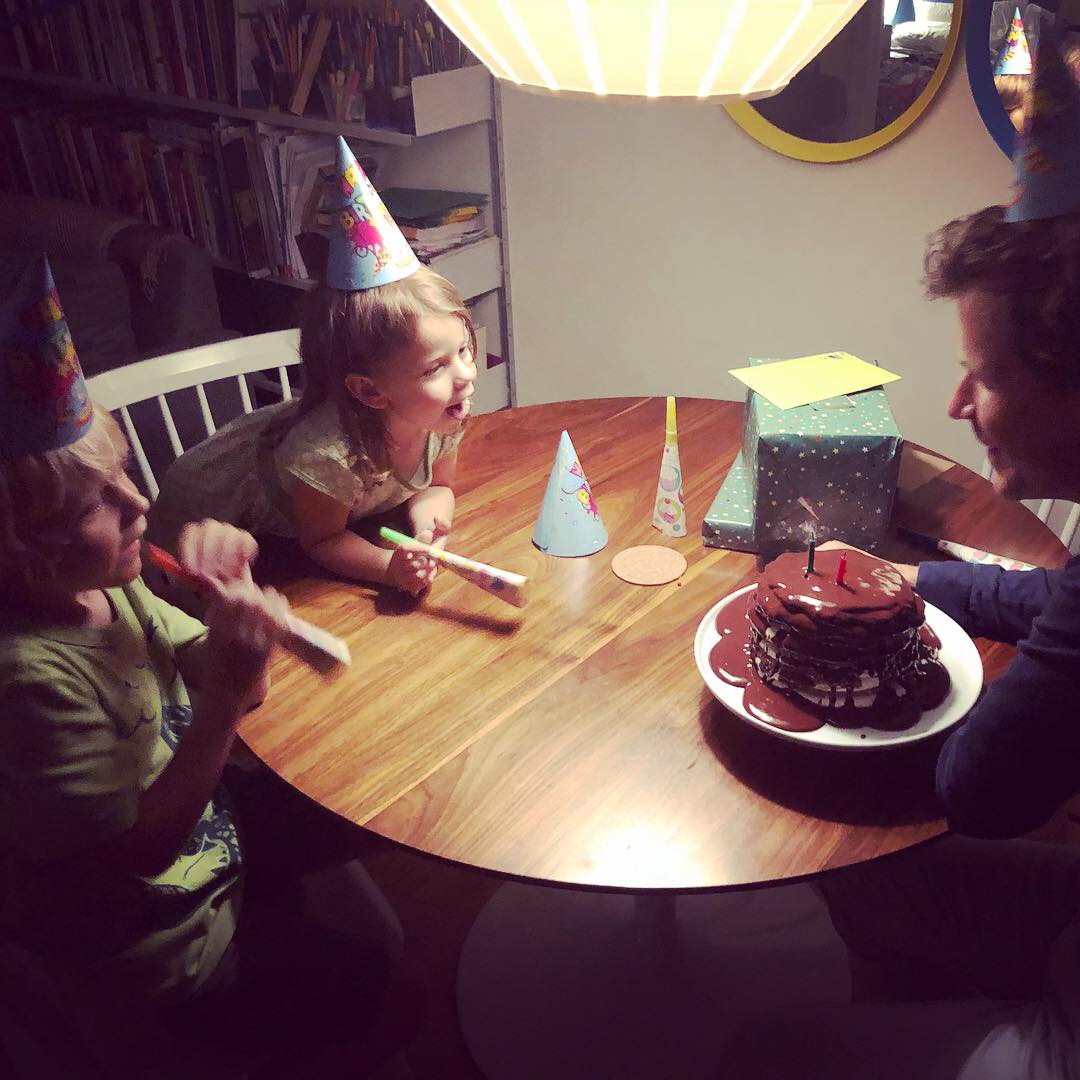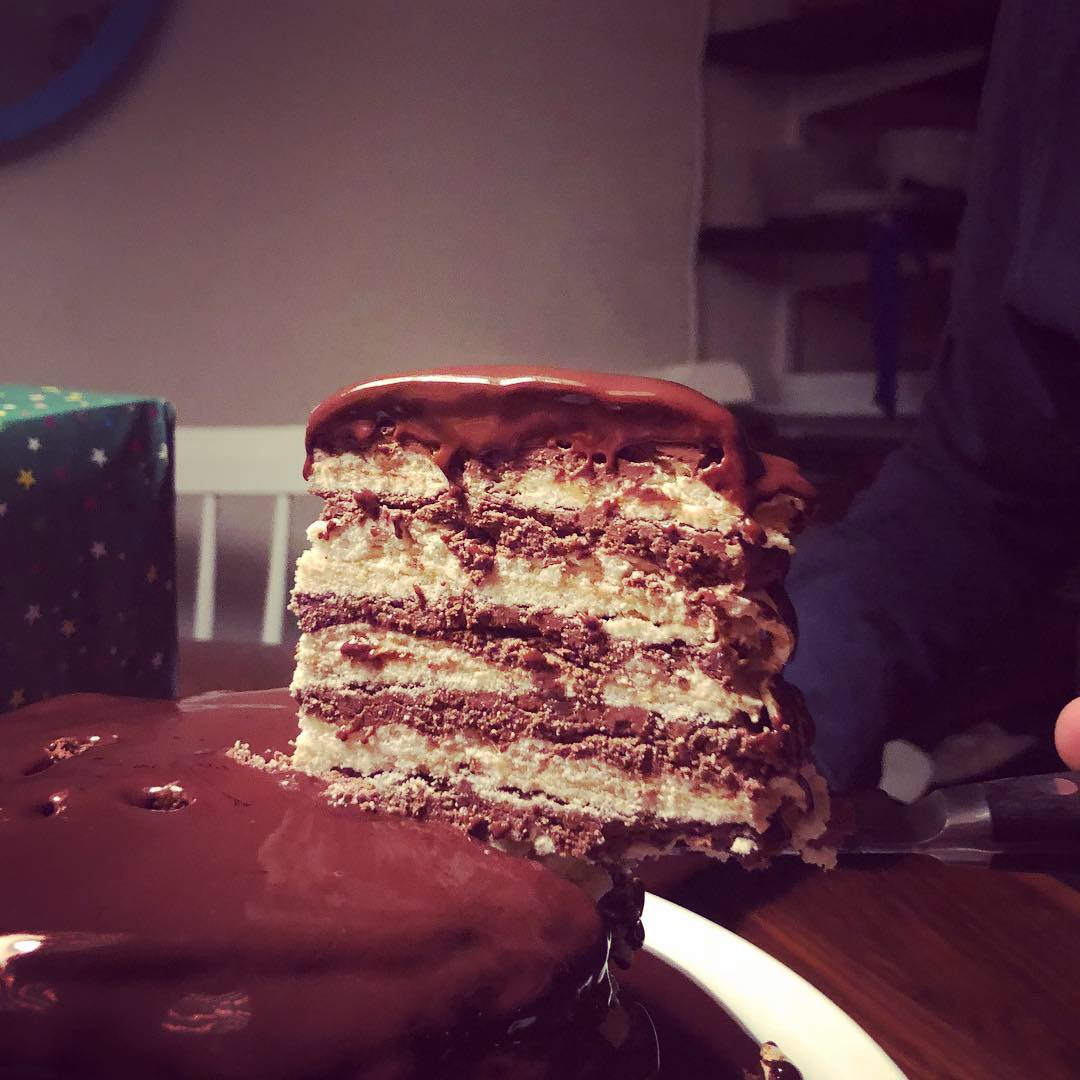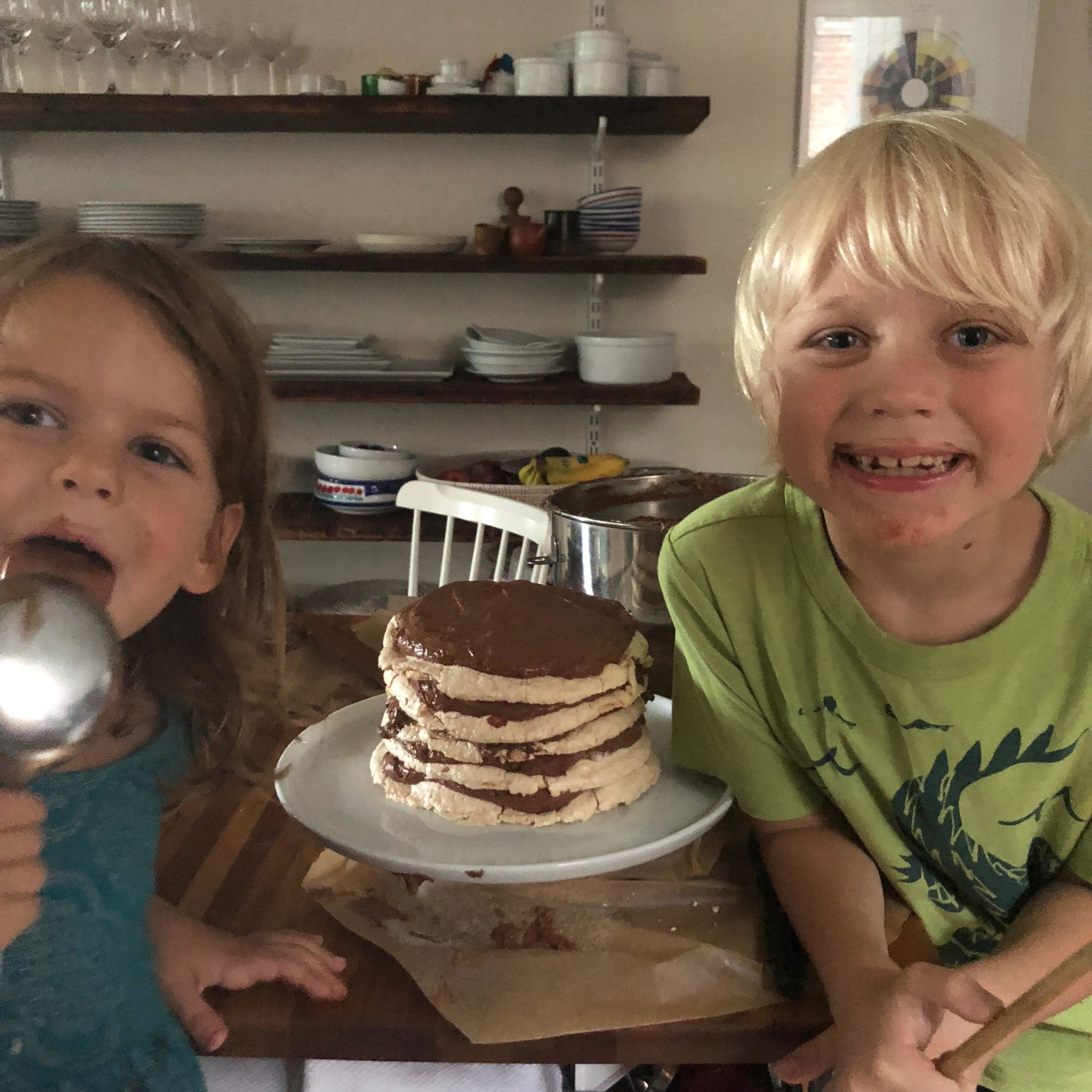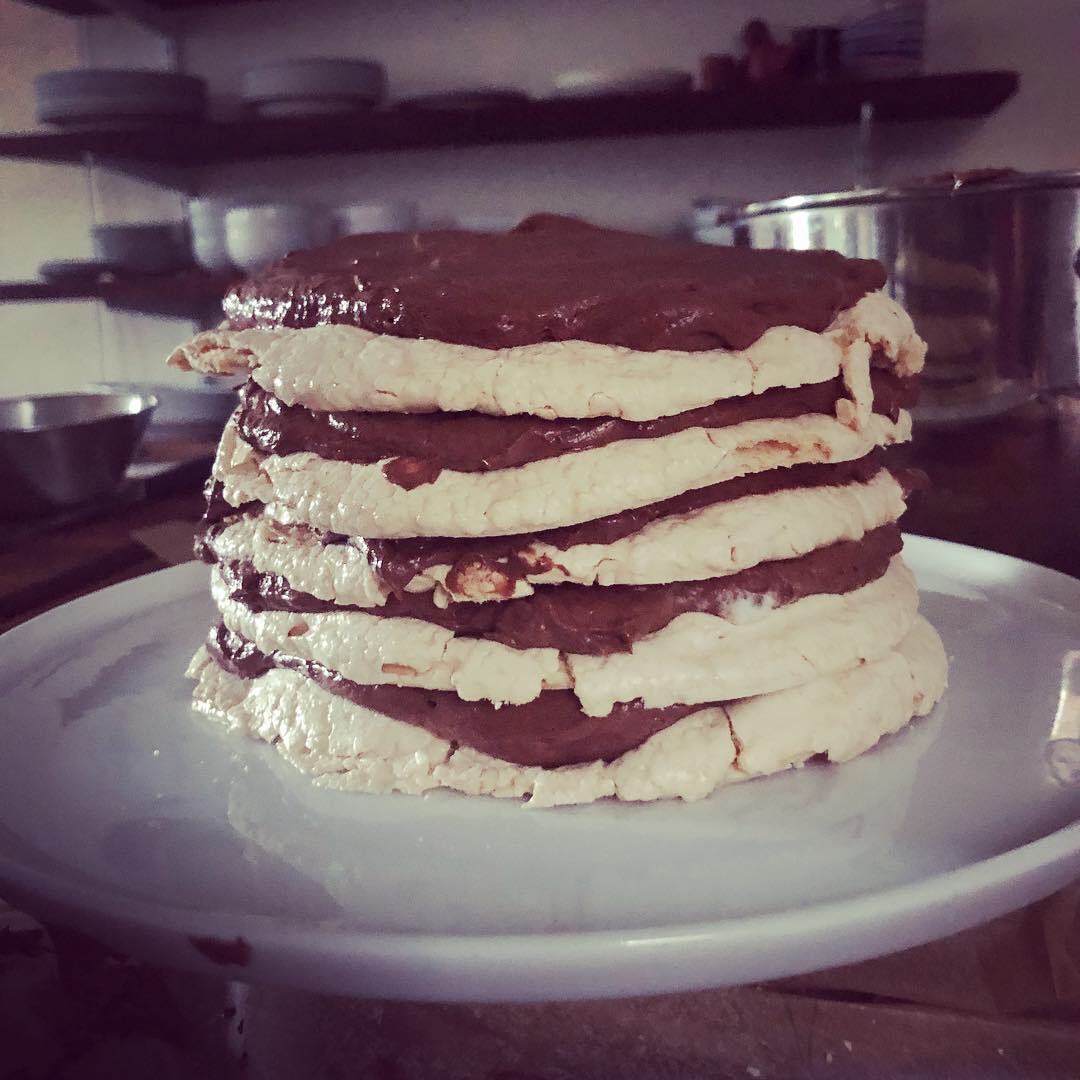Baking a cake takes a village, especially when it’s Pierre Hermé’s Autumn Meringue Cake, which is the kind of dessert you’d imagine in the pretty glass case of his rue Bonaparte shop in Paris. The cake is made of meringue and chocolate mousse layers, piled high and covered in a fudgy glaze. Hermé would never call it fudgy, but Dorie Greenspan, who wrote Desserts by Pierre Hermé (Little, Brown and Company) with him, might. I’ve always loved the flavors of chocolate mousse but it doesn’t have enough contrasting texture for me. This cake solves that. Think of it as a giant macaron without the ground almonds.
It’s the cake my husband, John wants every year on his birthday. And every year he makes it for himself.
John is the baker in our house. I’m the baker when I need to be – when I’m making Amanda Hesser’s Dump-It-Cake for a children’s party or testing recipes for work.
But this year, we couldn’t let him go it alone. So my kids and I whisked up three of the cake’s four components: the chocolate sauce, the chocolate mousse, and the chocolate glaze. John made the meringue.
As you make this cake, you begin to understand why some recipes belong to pastry chefs and others to home cooks. Hermé’s cake calls for a chocolate sauce of which only a few tablespoons are used in the mousse and glaze. I’m pretty convinced that you could cut this sauce entirely, adding some of its ingredients to other parts of the cake – maybe the crème fraîche could go directly into the mousse? That would make it a three-part cake instead of a four-part. But that’s for another day, another couple-hours worth of testing. I’d also add a little salt to all three parts of the cake. This book was written in 1998, before adding salt to desserts was SO on trend. I’d love to know why Hermé doesn’t add any salt cause I’m sure it’s for a reason. Finally, we made our cake narrower and taller. It’s supposed to be 3 9-inch layers of meringue and mousse for a total of 6 layers. We switched it to 5 layers of each, for a total of 10. The added height is impressive.
Here’s what I learned from finally making this cake:
1) sometimes making elaborate desserts and eating them on special occasions is worth the effort,
2) Dorie Greenspan is the most thorough and concise recipe writer of all time,
3) Pierre Hermé is a genius,
4) it does take a villages to raise children and make fancy cakes (can someone come over now and clean up my kitchen and kids?,
5) Autumn Meringue Cake could also be named Spring Passover Meringue Cake, as it’s both celebratory and flourless.
Below is the recipe. Brace yourself! And remember that dividing up the work between people or over days makes it manageable.
AUTUMN MERINGUE CAKE
Recipe adapted from “Desserts by Pierre Hermé,” written by Dorie Greenspan.
Serves 10 to 12
NOTE: All of the below cake components can be made and refrigerated ahead of the cake assembly. The sauce and glaze need to be rewarmed in a microwave or over a double boiler. See instructions for that below.
An instant read thermometer and piping bag are helpful. You can always make a piping bag though by cutting the corner of a Ziploc bag to 1/2 inch.
INGREDIENTS
FOR THE MERINGUE:
4 large egg whites
1 cup sugar
3/4 teaspoon vanilla extract
FOR THE CHOCOLATE SAUCE:
4 1/2 ounces bittersweet chocolate
1 cup water
1/2 cup crème fraîche
1/3 cup sugar
FOR THE CHOCOLATE MOUSSE:
9 ounces bittersweet chocolate
1 1/2 sticks unsalted butter, at room temperature
4 large eggs, separated
3 tablespoons Chocolate Sauce (recipe above)
1 tablespoon sugar
FOR THE CHOCOLATE GLAZE:
1/3 cup heavy cream
3 1/2 ounces bittersweet chocolate
4 teaspoons unsalted butter, cut into 4 pieces, softened
7 tablespoons Chocolate Sauce (recipe above), warm or at room temperature
INSTRUCTIONS
Make the Meringues:
1. Position the racks to divide the oven into thirds and preheat the oven to 250°F. Line two large baking sheets with parchment paper and fit a pastry bag with a plain 1/2-inch tip.
2. In an impeccably clean, dry mixing bowl with a clean, dry whisk attachment in place, whip the egg whites on high speed until they turn opaque and form soft peaks. Still whipping on high, gradually add half of the sugar and continue beating until the whites are glossy and hold firm peaks. Beat in the vanilla.
3. Using a rubber spatula, gradually fold in the remaining sugar. Work as quickly and delicately as you can to incorporate the sugar without deflating the whites.
4. To make meringue disks: pencil the outline of five 6-inch disks on the two pieces of parchment; turn the sheets of paper over. (If you can’t see the outline of the circles clearly now that the paper is flipped over, darken the pencil lines.) Gently spoon one third of the batter into the pastry bag and begin piping the batter at the center of a circle. Work your way in a spiral to the penciled edge and try to have each coil of batter touch the preceding coil. Pipe with light, consistent pressure and try to keep the disks thin – they shouldn’t be more than 1/3 inch high. Refill the bag twice more to pipe the remaining disks.
5. If there are any spaces in the disks, give them a once-over-lightly with a metal spatula. Place the baking sheets in the oven and insert the handle of a wooden spoon into the oven door to keep it slightly ajar. Bake the disks for 1½ to 2 hours, rotating the pans front to back and top to bottom two or three times, until firm and very lightly caramel colored. Turn off the oven and continue to dry the meringues for another 8 hours (or overnight) with the door closed.
6. Run an offset spatula under the cooled disks to loosen them from the paper.
Prepare the Chocolate Sauce:
7. Place all the ingredients in a heavy bottomed 2-quart saucepan and bring to the boil over medium heat, stirring constantly. Reduce the heat to low and simmer, stirring frequently, until the sauce thickens slightly and coats the back of a spoon (dip a wooden spoon into the sauce and draw your finger down the back of the spoon – if the sauce doesn’t run down, it’s done,) about 10 to 15 minutes. Let cool.
Prepare the Mousse:
8. Melt the chocolate in a metal bowl over, but not touching, simmering water or microwave gradually until melted. Set the chocolate aside and using a thermometer cool to 104°F.
9. In a mixer fitted with a whisk attachment, beat the butter on high until light and fluffy. Lower the speed and add the chocolate in three additions, increasing the speed and beating well after each addition, then lowering it again before the next addition. You want to beat as much air as possible into this butter-chocolate mixture. Whisk the yolks together with the chocolate sauce and beat it into the butter chocolate mixture.
10. In a super clean dry bowl with clean beaters, whip the egg whites until they become white and foamy, then add the sugar and whip until the whites hold soft peaks. Working with a large flexible rubber spatula, fold a quarter of the whites into the chocolate mixture to lighten it, then lightly fold in the rest of the whites.
Make the Chocolate Glaze:
11. In a small saucepan over medium heat, bring the heavy cream to a boil. Remove from the heat and, little by little, add the chocolate, stirring the mixture gently with a spatula in small circles. You want the chocolate temperature to reach 140°F. If it is too cool, warm it in a microwave or on top of a double boiler.
12. Slowly stir the butter and chocolate sauce into the 140°F chocolate mixer.
Assemble Cake:
13. Place a meringue disk, flat side down, on a cardboard cake circle. (You can glue it to the cardboard using a dab of mousse in the center.) Spread one fifth of the mousse evenly over the disk. (If the meringue breaks, glue it together with mousse.) Top with a second meringue disk, and then another one-fifth of the mousse. Repeat until all the disk and mousse has been used. Refrigerate for 2 hours to firm.
14. Just before pouring the glaze over the cake, warm it to 114°F in a microwave or over a double boiler.
15. Place cake on a cooling rack set over a wax paper-lined baking sheet. Pour the warmed glaze over the cake, letting it run down the sides. Serve immediately or let set in the fridge. If refrigerated for over 6 hours, let rest for 1 hour at room temp before serving.





